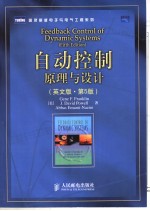图书介绍
FEEDBACK CONTROL OF DYNAMIC SYSTEMS (FIFTH EDITION)PDF|Epub|txt|kindle电子书版本网盘下载

- [美]GENE F.FRANKLIN J.DAVID POWELL ABBAS EMAMI-NAEINI著 著
- 出版社: 人民邮电出版社
- ISBN:9787115158536
- 出版时间:2007
- 标注页数:609页
- 文件大小:63MB
- 文件页数:624页
- 主题词:自动控制理论-英文;自动控制系统-系统设计-英文
PDF下载
下载说明
FEEDBACK CONTROL OF DYNAMIC SYSTEMS (FIFTH EDITION)PDF格式电子书版下载
下载的文件为RAR压缩包。需要使用解压软件进行解压得到PDF格式图书。建议使用BT下载工具Free Download Manager进行下载,简称FDM(免费,没有广告,支持多平台)。本站资源全部打包为BT种子。所以需要使用专业的BT下载软件进行下载。如BitComet qBittorrent uTorrent等BT下载工具。迅雷目前由于本站不是热门资源。不推荐使用!后期资源热门了。安装了迅雷也可以迅雷进行下载!
(文件页数 要大于 标注页数,上中下等多册电子书除外)
注意:本站所有压缩包均有解压码: 点击下载压缩包解压工具
图书目录
1 An Overview and Brief History of Feedback Control1
A Perspective on Feedback Control1
Chapter Overview1
1.1 A Simple Feedback System2
1.2 A First Analysis of Feedback5
1.3 A Brief History7
1.4 An Overview of the Book12
Summary13
End-of-Chapter Questions14
Problems14
2 Dynamic Models17
A Perspective on Dynamic Models17
Chapter Overview17
2.1 Dynamics of Mechanical Systems18
2.2 Models of Electric Circuits28
2.3 Models of Electromechanical Systems31
2.4 Heat and Fluid-Flow Models36
2.5 Complex Mechanical Systems45
Summary49
End-of-Chapter Questions49
Problems50
3 Dynamic Response58
A Perspective on System Response58
Chapter Overview58
3.1 Review of Laplace Transforms58
3.2 System Modeling Diagrams80
3.3 Effect of Pole Locations84
3.4 Time-Domain Specifications90
3.5 Effects of Zeros and Additional Poles94
3.6 Amplitude and Time Scaling98
3.7 Stability100
3.8 Obtaining Models from Experimental Data108
3.9 Mason’s Rule and the Signal-Flow Graph109
Summary112
End-of-Chapter Questions113
Problems114
4 Basic Properties of Feedback127
A Perspective on the Properties of Feedback127
Chapter Overview127
4.1 The Basic Equations of Control128
4.2 Control of Steady-State Error: System Type134
4.3 Control of Dynamic Error: PID Control142
4.4 Extensions to the Basic Feedback Concepts146
Summary160
End-of-Chapter Questions161
Problems161
5 The Root-Locus Design Method177
A Perspective on the Root-Locus Design Method177
Chapter Overview177
5.1 Root Locus of a Basic Feedback System178
5.2 Guidelines for Sketching a Root Locus182
5.3 Selected Illustrative Root Loci191
5.4 Selecting the Parameter Value201
5.5 Design Using Dynamic Compensation203
5.6 A Design Example Using the Root Locus210
5.7 Extensions of the Root-Locus Method215
Summary222
End-of-Chapter Questions223
Problems224
6 The Frequency-Response Design Method239
A Perspective on the Frequency-Response Design Method239
Chapter Overview239
6.1 Frequency Response240
6.2 Neutral Stability256
6.3 The Nyquist Stability Criterion258
6.4 Stability Margins267
6.5 Bode’s Gain-Phase Relationship272
6.6 Closed-Loop Frequency Response275
6.7 Compensation276
6.8 Alternative Presentations of Data295
6.9 Specifications in Terms of the Sensitivity Function299
6.10 Time Delay305
Summary307
End-of-Chapter Questions309
Problems310
7 State-Space Design329
A Perspective on State-Space Design329
Chapter Overview329
7.1 Advantages of State Space330
7.2 System Description in State Space331
7.3 Block Diagrams and State Space336
7.4 Analysis of the State Equations339
7.5 Control-Law Design for Full-State Feedback355
7.6 Selection of Pole Locations for Good Design366
7.7 Estimator Design374
7.8 Compensator Design: Combined Control Law and Estimator385
7.9 Introduction of the Reference Input with the Estimator396
7.10 Integral Control and Robust Tracking406
7.11 Loop Transfer Recovery (LTR)420
7.12 Direct Design with Rational Transfer Functions424
7.13 Design for Systems with Pure Time Delay427
Summary431
End-of-Chapter Questions432
Problems434
8 Digital Control452
A Perspective on Digital Control452
Chapter Overview452
8.1 Digitization452
8.2 Dynamic Analysis of Discrete System454
8.3 Design Using Discrete Equivalents460
8.4 Hardware Characteristics468
8.5 Sample-Rate Selection471
8.6 Discrete Design473
8.7 State-Space Design Methods479
Summary485
End-of-Chapter Questions486
Problems487
9 Nonlinear Systems497
Perspective on Nonlinear Systems497
Chapter Overview497
9.1 Introduction and Motivation: Why Study Nonlinear Systems?498
9.2 Analysis by Linearization499
9.3 Equivalent Gain Analysis Using the Root Locus505
9.4 Equivalent Gain Analysis Using Frequency Response: Describing Functions513
9.5 Analysis and Design Based on Stability522
Summary537
End-of-Chapter Questions537
Problems538
10 Control System Design: Principles and Case Studies545
A Perspective on Design Principles545
Chapter Overview545
10.1 An Outline of Control Systems Design545
10.2 Design of a Satel lite’s Attitude Control550
10.3 Lateral and Longitudinal Control of a Boeing 747561
10.4 Control of the Fuel-Air Ratio in an Automotive Engine574
10.5 Control of the Read/Write Head Assembly of a Hard Disk580
10.6 Control of Rapid Thermal Processing (RTP) Systems in Semiconductor Wafer Manufacturing586
Summary597
End-of-Chapter Questions599
Problems599